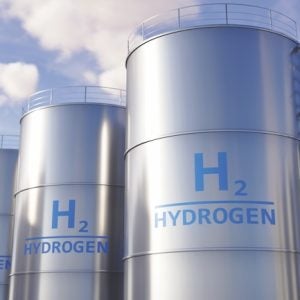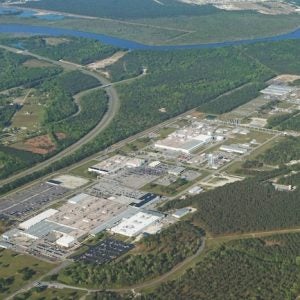Concentrates resulting from the evaporation of the contaminated water treatment systems are currently stored in ten Evaporator Concentrate Tanks (ECT), each with a 500m3 capacity. These cylindrical tanks are 10m in diameter and 7m high. The tanks, made from metal, are located in Auxiliary Buildings 1 & 2. Five of the tanks are in Auxiliary Building 1 (AB 1) with the other five in Auxiliary Building 2 (AB 2). Tanks are located inside individual compartments separated by concrete walls coated with metal linings. A concrete roof covers each row of five tank compartments and there are openings in the roofs above each tank. Approximately 80% of the volume of each tank is filled with a solidified compound which has settled with time and is now in the form of a multiple-layer solid. The remainder is a saturated salt solution, which will be removed from each of the ten tanks prior to sampling.
Although chemical compositions of solid phases in each tank may vary from tank to tank, boric acid (H3BO3) represents approximately 80% in weight of the total solid. The other main components of the solid are sodium nitrate (NaNO3) and potassium nitrate (KNO3) in a 1:10 weight ratio. In 2010, the main activity of the solid phase will come from cobalt-60, cesium-134 and cesium-137. According to the technical specifications, no more than 10% of the initial volume of the solidified phase will be category 2a waste. This category includes low and intermediate-level waste with mainly alpha-emitters in concentrations that do not require special heat-removal measures during storage and disposal.
In February 2009, Onet Technologies of France won a contract from the Kozloduy International Decommissioning Support Fund, administered by the European Bank for Reconstruction and Development, to decontaminate the waste. In total, it must produce no more than 360m3 of category 2a radioactive waste from 3600m3 of solid. It is not allowed to produce category 2b (or higher) waste. The residual activity of the decontaminated concentrates must be less than category 1 levels (waste that can be considered as conventional waste after 5 years of decay). In order to achieve this task, decontamination factors as high as 3000 will be obtained. Onet is currently collecting data for equipment design.
Sampling

In sampling, a technician operates a percussion hammer through a glovebox.
Solids in each of the 10 tanks will be sampled. Operations will be carried out in compliance with the safety and radiation protection requirements in force at Kozloduy NPP.
Sampling operations will take place on the roof above the tanks at an elevation of 6.3m. Two ISO 20ft containers will be installed here, one on top of the other. This sampling equipment will be moveable: once operations in a tank are completed, the equipment must be safely dismounted, transported and reassembled in another location. These two containers are the first safety protection barriers of the complete sampling system.
A glove-box will be installed in the first ISO container, this glove-box being the second safety barrier of the system. It will be fitted with a removable container that will enable contaminated material and samples to be released.
A worker located inside the ISO container will be in a position to operate directly in front of the glove-box in order to carry out his task. The ventilation system equipment will be installed in the top container.
The first step of the work will be to drill through the concrete platform of the roof to reach the ECT compartment. A drill fitted with a diamond head will cut a 500mm deep hole in concrete.
Once the drilled piece of concrete is removed, the cutter head will be changed to drill into metal. The drilling head must capture the roof section, and return it inside the glove-box for removal and future disposal. A confinement stack will be fitted between the bottom of the container and the opening in the top of the tank to prevent any leakages. The first opening in the concrete may be closed by a sealed flange. The tightness of the second hole will be ensured by a conical rubber seal. A constant air flow circulating from the glove-box to the tank will prevent any contaminated dust from entering the glove-box. Then the system will be ready for sampling.
In the sampling process, a percussion hammer drives a percussion gouge fitted with hardened cutting heads into the solid. An hydraulic extractor retrieves the gouges and automatically switches off. The extractor system consists of 65mm-diameter extracting cylinder, hydraulic aggregate with electric-hydraulic extractor tube set, and bottom plate with handle and a ball clamp. The operator places the gouge, filled with evaporate concentrate, horizontally in the glove box. A gouge container is clamped on the glove box and is maintained on a lifting table. A door ensures confinement while the operator pushes the sample into the container. The door is closed and the container is disengaged. These coring operations are repeated as much as required, with gouges of smaller and smaller diameter, to remove an entire cylindrical column of the solid. Gouge diameters are 100mm, 75mm, 60mm, 50mm and 40mm. Three different samples will be retrieved from different places in each tank.

The technician drills with progressively smaller gouges
The solid sample will be made homogeneous by an appropriate procedure and sent to a laboratory for further analysis. Analyses should include alpha and gamma spectroscopy (and gamma repartition between soluble and insoluble compounds). The average composition of the beta pure emitters, the main salts (anions and cations), and the amount of organic compounds should also be determined. The characterisation of the solid phase in each tank will be done on the basis of three samples. The results of the analyses will help in designing the necessary equipment to retrieve and process the solid phase.
Retrieval & processing

The cleanup operation will use the same tank penetrations to insert a nozzle that sprays a chemical solution at high pressure to dissolve the salt.
Retrieval operations will start with the least-contaminated tank. Radioactive materials in the most contaminated tanks will continue to decay as the first tanks are processed.
The solid will be dissolved by a high-pressure water jet fed by a filtered salt solution. Preliminary studies will help optimise the operational conditions (i.e. salt concentration, temperature and pH) to reach the best dissolution conditions.
The operator will insert a pole into the tank through each of the three holes drilled during the sampling phase. The lower part of the pole will be fitted with a rotating nozzle and the pole will be articulated to cover the largest possible area. A set of extensions will allow the pole geometry to be changed.
Retrieval tools, a pole support and a confinement will be installed in the containers. A light and camera will be lowered through the same hole to provide the operator with a view of the inside of the tank. The water jet will disaggregate the compacted solidified phase, increasing its surface area and improving salt dissolution. A submerged vane pump fitted with flexible blades will be lowered into the ECT tank to mix the solution, speeding up dissolution.
Dissolution will be completed in a dissolution tank. Water, soda and nitric acid for pH readjustment will be poured into the dissolution tank to maintain the optimum pH.
The retrieval and dissolution operations will be conducted in several-thousand-litre batches. The end of dissolution (specified by the set optimised concentration) will be controlled by density measurement of the salted solution.
Once the solution has a neutral pH and a concentration of 150g/L, it will be filtered before being decontaminated.
Tangential membrane filtration with a cutoff of 0.1µm traps all solid particles in suspension in the solution before ion exchange. The few alpha emitters present in the salts and a part of the cobalt will be extracted as sludge at this stage. The sludge will be solidified into 40L drums, and the drums will be cemented in concrete containers and then sent out for disposal as category 2a waste.
Next, the contaminated solution flows into ion exchange cartridges. These cartridges contain an inorganic ion-exchange medium that fix cobalt-60, cesium-134 and cesium-137 radionuclides to a solid support. This process was developed by Onet Technologies Grands Projets subcontractor Fortum. The ion exchange cartridges are used until their complete saturation. When cesium and cobalt treatment cartridges are saturated, they are replaced by new ones. The cartridges are enclosed into shielded vessels to protect personnel in charge of their operation. Once saturated, the vessels are opened and cartridges are removed by remote control. The contaminated ion exchange resins are further cemented in concrete containers and then sent out for disposal as category 2a waste.
Once free of cobalt and cesium, the salt solution is then heated and compressed before being flashed in an atmospheric evaporator. Water is collected by condensation at the top of the evaporator. This water is recycled back to feed the water jets. Crystallised salts are collected in big bags at the bottom of the evaporator and then sent out for disposal as category 1 waste.
Related ArticlesOnet Technologies opens a Slovakian subsidiary Kozloduy units closed as Bulgaria joins EU Kozloduy 1&2 dismantling Novel waste encapsulation Calls for Kozloduy closure cash European funding extension for Bulgarian decommissioning






